Mattingly J.D., Heiser W.H., Pratt D.T. Aircraft Engine Design
Подождите немного. Документ загружается.


366 AIRCRAFT ENGINE DESIGN
parallel. Flow exits the control volume at station 3, which is assumed to be suf-
ficiently far downstream so that the flame front has reached the walls. The upper
and lower walls are the confining boundaries of the control volume.
The gas is assumed to behave as a Boussinesq fluid, that is, flow is at low
Mach number, and the mass density varies only with temperature, u Consequently,
to2
-~-
-gABP3,
where
"gAB
is the ratio of total temperature rise across the afterburner.
The cross-sectional areas of the flow are (H - W) at entry station 2 and H at
exit station 3. Mass conservation requires that
p2A2U2
= p3A3 U3.
Note that the
static pressure at station 2 acts across the entire area, but flow enters only between
the wall and the outer edge of the recirculation bubble. Conservation of linear
momentum across the control volume gives
P2H
+
p2U~ (H
-
W)
=
P3H
+
p3U23 H
(9.80)
The total pressure drop across the control volume is, by definition,
APt ":" Pt2 - Pt3 -~
(P2 q- q2) - (P3 q- q3) = (P2 - P3) + (q2 - q3) (9.81)
Noting that
pU 2
= 2q, and substituting for (P3 - P2) from Eq. (9.80), Eq. (9.81)
may be rewritten as
APt = [2q3 -- 2q2 (1-- ~)] + (q2 -q3) = q3 -- q2 (1- 2i_i W)
(9.82)
Nondimensionalizing by the upstream dynamic pressure ql and simplifying,
there follows an expression for the afterburner total pressure loss coefficient,
k ql /AB P3
W 2
= (tAB --
1) + (H - W) 2 (9.83)
A similar linear momentum conservation control volume analysis between
stations 1 and 2 on Fig. 9.2b can be used to find an expression for the drag coeffi-
cient CD of the vee-gutter flameholder,
CD ._ Fdrag H W 2
-- (9.84)
ql D D (H - W) 2
where
Fdrag
is the aerodynamic drag force on the vee-gutter, H is the channel height,
and D is the height or lateral dimension of the gutter, as shown on Fig. 9.2b.
With Eq. (9.84) substituted into Eq. (9.83), the total pressure loss coefficient
can be expressed as
APt')
=(rAB--1)+CDB
ql /lAB
(9.85)
where B is the "blockage," B =
D/H.
Note that when the afterbumer is not tumed on, so that taB = 1, Eq. (9.85) gives
the "cold" or "dry" loss of the afterbumer caused solely by the aerodynamic drag
of the vee-gutters.

DESIGN: COMBUSTION SYSTEMS 367
The total pressure ratio is related to the total pressure loss coefficient by
TfAB
":- ~tl --
1 - 1 + = 1 - (9.86)
\ ql /lAB 1 + 2/yM21
All that remains to be done is to establish a relationship between the maximum
wake width W, channel height H, and the vee-gutter dimensions D and half-
angle 0. Citing a potential flow solution to this geometry published by von Mises
in 1917, Cornell presents a graph of the variation of W/H as a function of blockage
B = D/H for values of half-angle 0 between 0 and 180 deg (Ref. 25). Cornell's
graphical solution can be represented to good approximation by a curve-fit,
W ~ B + (1 - ~/-B) v/B sin (0//2) (9.87)
H
Equations (9.83-9.87) constitute the desired estimate of total pressure loss for
the afterburner, neglecting wall friction. By inspection of Eq. (9.83), it is apparent
that the total pressure loss is at its least value when W = 0, that is, when there
is no vee-gutter at all. At the other limit the total pressure loss increases without
bound as W approaches H, that is, as the vee-gutter wake fills the entire channel.
Because there is no optimal set of parameters that minimize the afterburner total
pressure loss, the vee-gutters will just be made as small as possible while still able
to function as flameholders. The choice of afterburner channel height H, vee-gutter
dimensions D, and half-angle 0 to ensure adequate flameholding will be dealt with
in Sec. 9.3.
9.1.6 Fuels
In the early development of the gas turbine engine, it was commonly believed
that the engine could use any fuel that would burn. While this is true in theory,
it is not so in practice. The modern turbojet engine is quite particular about the
fuel used, due to the high rate of fuel flow and wide temperature and pressure
variations.
Jet fuel is refined from crude oil petroleum. A typical pound of jet fuel might
be composed of 16% hydrogen atoms, 84% carbon atoms, and small amounts
of impurities such as sulfur, nitrogen, water, and sediment. Various grades of jet
fuel have evolved during the development of the jet engines in an effort to ensure
both satisfactory performance and adequate supply. Historically, JP-4 was the most
commonly used fuel for U.S. Air Force jet engines, while the U.S. Navy used JP-5,
a denser, less volatile fuel than JP-4 that offered less explosion hazard when stored
in the skin tanks of ships than did JP-4. At the present time, the most common
fuels in both military and commercial aircraft are Jet A and JP-8 (Jet A-l). They
are much alike, except that Jet A has a freezing point below -40°F while JP-8/
Jet A-1 has a freezing point below -58°E Table 9.4 gives specifications for the
most commonly used jet fuels.
Many aircraft engines are built to operate on any of these fuels. To do so, they
must have a special switch on the fuel control to compensate for differences in the
specific gravity which is used in fuel metering calculations.

368
AIRCRAFT ENGINE DESIGN
Table 9.4 Jet engine fuels a
JP-4 JP-5 JP-8 (Jet A-l)
Specific Specific Specific
Property requirement Typical requirement Typical requirement Typical
Vapor pressure, atm 0.13-0.2 0.18 0.003 0.007
@ 38°C (100°F)
Initial boiling point, °F 140 360 336
Endpoint, °F 475 550 500 550 509
Flash point, °F - 13 > 145 149 > 120 126
Aromatic content (% vol.) <25 12 <25 16 <20 16
Olefinic content (% vol.) <5 1 1 1
Saturates content (% vol.) 87 83 83
Net heat of combustion, > 18,400 18,700 > 18,300 18,500 > 18,400 18,600
BTU/lbm
Specific gravity 0.751-0.802 0.758 0.788-0.845 0.818 0.733-0.830 0.710
all. R. Lander, private communication, Cleveland, OH, May 2001.
9.1.7 Ignition
In the main burner an ignition source is required for initial startup, as well as
for relight following flameout or blowout. An ignition source is also required to
ignite the afterburner. Usually, an electrical spark igniter is used for both applica-
tions (Appendix 0).
In the main burner the spark igniter must be located in the primary zone in a
location where the air/fuel mixture passes over the electrodes. However, because
the spark igniter does not function during steady-state operation of the engine, it
must also be located far enough away from the hottest part of the primary zone
recirculation bubble so that the electrodes are not eroded or burned away. Because
an ignited primary zone can propagate a flame laterally to ignite neighboring
primary zones, not every primary zone has to have its own spark igniter. Deter-
mining the optimal location and number, as well as the level of electrical power that
must be provided for the spark to be effective, is based on experience and trial and
error.
In the afterburner the ignition source must be located somewhat upstream of
one or more of the vee-gutters, but of course far enough downstream from the
fuel injectors for adequate fuel/gas mixing to be achieved. Although more than
one igniter is required, the number of igniters and their location is again largely a
matter of experience and trial and error.
Preliminary design of the ignition subsystems of both the main burner and
afterburner is considered to be too complex and specialized to be considered
here.
9.2 Design ToolsmMain Burner
Procedures for preliminary design of the main burner are the subject of the
present section. Extensive use will of course be made of concepts and equations
from the preceding Sec. 9.1. A complete example calculation illustrating the use
of the AEDsys computational tools, primarily programs EQL, MAINBRN, and
KINETX, can be found in Sec. 9.4.1.
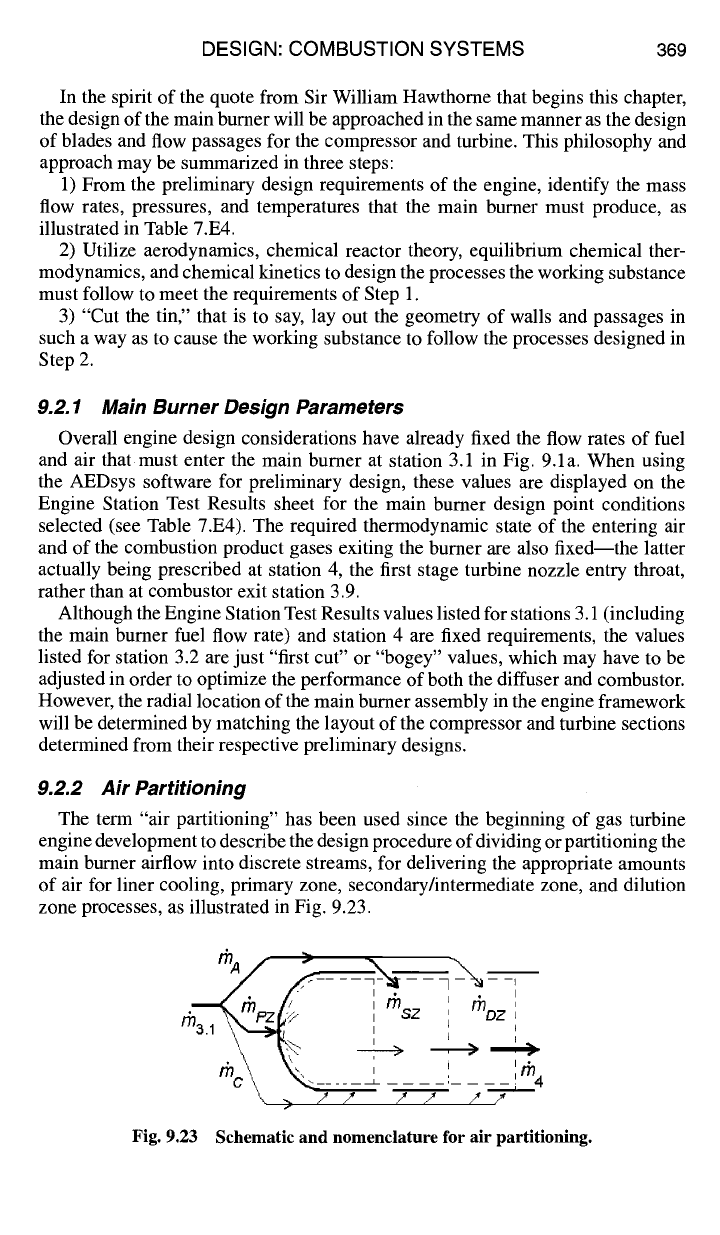
DESIGN: COMBUSTION SYSTEMS 369
In the spirit of the quote from Sir William Hawthorne that begins this chapter,
the design of the main burner will be approached in the same manner as the design
of blades and flow passages for the compressor and turbine. This philosophy and
approach may be summarized in three steps:
1) From the preliminary design requirements of the engine, identify the mass
flow rates, pressures, and temperatures that the main bumer must produce, as
illustrated in Table 7.E4.
2) Utilize aerodynamics, chemical reactor theory, equilibrium chemical ther-
modynamics, and chemical kinetics to design the processes the working substance
must follow to meet the requirements of Step 1.
3) "Cut the tin," that is to say, lay out the geometry of walls and passages in
such a way as to cause the working substance to follow the processes designed in
Step 2.
9.2.1 Main Burner Design Parameters
Overall engine design considerations have already fixed the flow rates of fuel
and air that must enter the main burner at station 3.1 in Fig. 9.1a. When using
the AEDsys software for preliminary design, these values are displayed on the
Engine Station Test Results sheet for the main burner design point conditions
selected (see Table 7.E4). The required thermodynamic state of the entering air
and of the combustion product gases exiting the burner are also fixed--the latter
actually being prescribed at station 4, the first stage turbine nozzle entry throat,
rather than at combustor exit station 3.9.
Although the Engine Station Test Results values listed for stations 3.1 (including
the main burner fuel flow rate) and station 4 are fixed requirements, the values
listed for station 3.2 are just "first cut" or "bogey" values, which may have to be
adjusted in order to optimize the performance of both the diffuser and combustor.
However, the radial location of the main burner assembly in the engine framework
will be determined by matching the layout of the compressor and turbine sections
determined from their respective preliminary designs.
9.2.2 Air Partitioning
The term "air partitioning" has been used since the beginning of gas turbine
engine development to describe the design procedure of dividing or partitioning the
main burner airflow into discrete streams, for delivering the appropriate amounts
of air for liner cooling, primary zone, secondary/intermediate zone, and dilution
zone processes, as illustrated in Fig. 9.23.
fn c
%
// i m ~ ,
'zt, i sz oz,
X, , 'rb
..... J .........
1 4
> /'7 I / ~ /~ I
Fig. 9.23 Schematic and nomenclature for air partitioning.
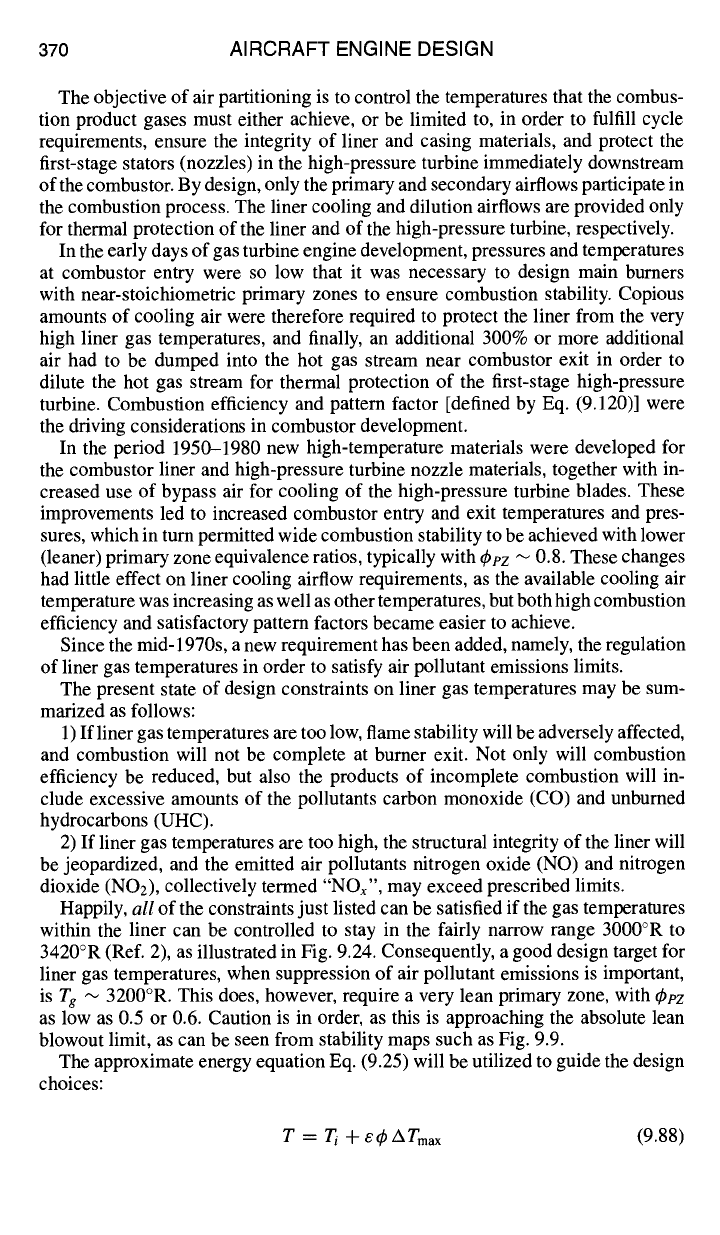
370 AIRCRAFT ENGINE DESIGN
The objective of air partitioning is to control the temperatures that the combus-
tion product gases must either achieve, or be limited to, in order to fulfill cycle
requirements, ensure the integrity of liner and casing materials, and protect the
first-stage stators (nozzles) in the high-pressure turbine immediately downstream
of the combustor. By design, only the primary and secondary airflows participate in
the combustion process. The liner cooling and dilution airflows are provided only
for thermal protection of the liner and of the high-pressure turbine, respectively.
In the early days of gas turbine engine development, pressures and temperatures
at combustor entry were so low that it was necessary to design main burners
with near-stoichiometric primary zones to ensure combustion stability. Copious
amounts of cooling air were therefore required to protect the liner from the very
high liner gas temperatures, and finally, an additional 300% or more additional
air had to be dumped into the hot gas stream near combustor exit in order to
dilute the hot gas stream for thermal protection of the first-stage high-pressure
turbine. Combustion efficiency and pattern factor [defined by Eq. (9.120)] were
the driving considerations in combustor development.
In the period 1950-1980 new high-temperature materials were developed for
the combustor liner and high-pressure turbine nozzle materials, together with in-
creased use of bypass air for cooling of the high-pressure turbine blades. These
improvements led to increased combustor entry and exit temperatures and pres-
sures, which in turn permitted wide combustion stability to be achieved with lower
(leaner) primary zone equivalence ratios, typically with q~pz "~ 0.8. These changes
had little effect on liner cooling airflow requirements, as the available cooling air
temperature was increasing as well as other temperatures, but both high combustion
efficiency and satisfactory pattem factors became easier to achieve.
Since the mid-1970s, a new requirement has been added, namely, the regulation
of liner gas temperatures in order to satisfy air pollutant emissions limits.
The present state of design constraints on liner gas temperatures may be sum-
marized as follows:
1) If liner gas temperatures are too low, flame stability will be adversely affected,
and combustion will not be complete at burner exit. Not only will combustion
efficiency be reduced, but also the products of incomplete combustion will in-
clude excessive amounts of the pollutants carbon monoxide (CO) and unburned
hydrocarbons (UHC).
2) If liner gas temperatures are too high, the structural integrity of the liner will
be jeopardized, and the emitted air pollutants nitrogen oxide (NO) and nitrogen
dioxide (NO2), collectively termed "NOx", may exceed prescribed limits.
Happily,
all
of the constraints just listed can be satisfied if the gas temperatures
within the liner can be controlled to stay in the fairly narrow range 3000°R to
3420°R (Ref. 2), as illustrated in Fig. 9.24. Consequently, a good design target for
liner gas temperatures, when suppression of air pollutant emissions is important,
is
Tg ,~
3200°R. This does, however, require a very lean primary zone, with ~bpz
as low as 0.5 or 0.6. Caution is in order, as this is approaching the absolute lean
blowout limit, as can be seen from stability maps such as Fig. 9.9.
The approximate energy equation Eq. (9.25) will be utilized to guide the design
choices:
T = T~ + egoATmax
(9.88)
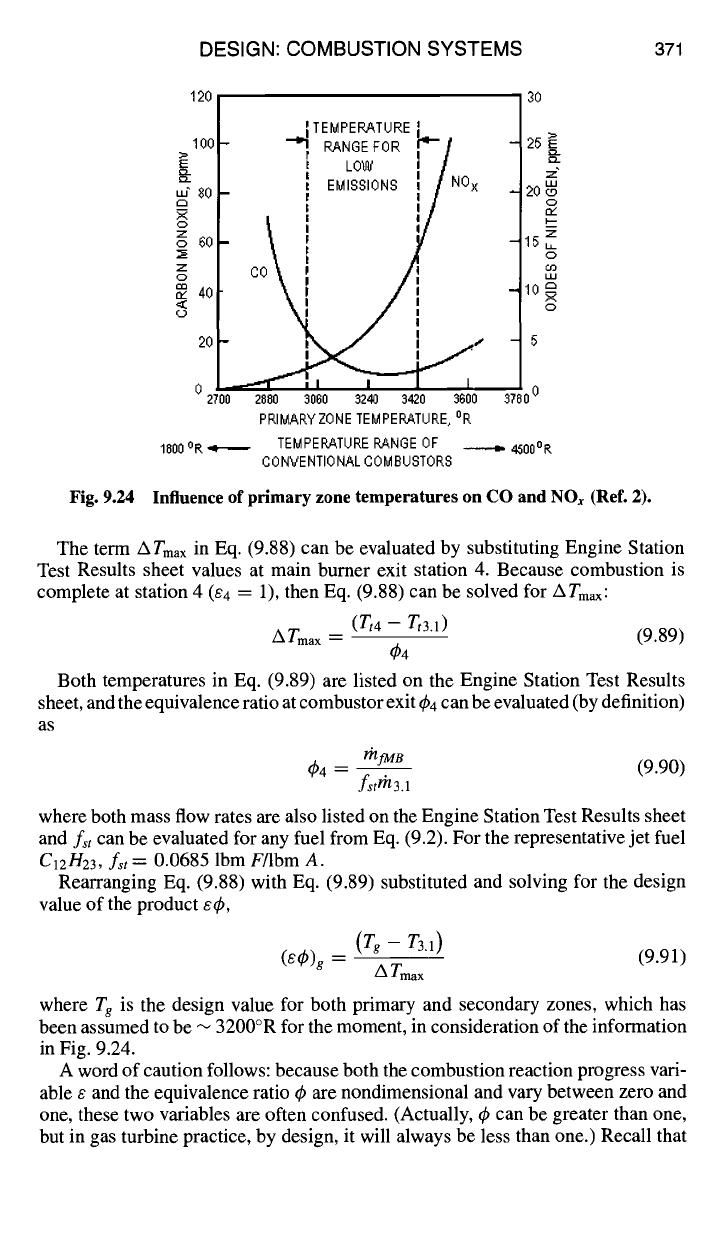
DESIGN: COMBUSTION SYSTEMS 371
Fig. 9.24
120 30
l TEMPERATURE I
100 ~ RANGEFOR ~'-I - 25~
~" ~0 t EMISSIONS I I x 20
N
co\ i
Ii
10"-'
40
, ,
o 'q /i
20 ~,,' 5
0
2700 2880 3060 3240 3420 3600 37800
PRIMARY ZONE TEMPERATURE, OR
1800 °R ~ TEMPERATURE RANGE OF - ~ 4500%
CONVENTIONAL COIdBUSTORS
Influence of primary zone temperatures on CO and NOx (Ref. 2).
The term ATmax in Eq. (9.88) can be evaluated by substituting Engine Station
Test Results sheet values at main burner exit station 4. Because combustion is
complete at station 4 (s4 = 1), then Eq. (9.88) can be solved for ATmax:
(Tt4 --
Tt3,1)
ATmax -- (9.89)
4'4
Both temperatures in Eq. (9.89) are listed on the Engine Station Test Results
sheet, and the equivalence ratio at combustor exit ~b4 can be evaluated (by definition)
as
rhyM8
44 -- --
(9.90)
fstgn3.1
where both mass flow rates are also listed on the Engine Station Test Results sheet
and
f,t
can be evaluated for any fuel from Eq. (9.2). For the representative jet fuel
C12H23,
fst ~--
0.0685
Ibm F/Ibm A.
Rearranging Eq. (9.88) with Eq. (9.89) substituted and solving for the design
value of the product s4~,
(Tg -
T3.1) (9.91)
(e~b)g -- ATmax
where
Tg
is the design value for both primary and secondary zones, which has
been assumed to be "-~ 3200°R for the moment, in consideration of the information
in Fig. 9.24.
A word of caution follows: because both the combustion reaction progress vari-
able s and the equivalence ratio q~ are nondimensional and vary between zero and
one, these two variables are often confused. (Actually, ~b can be greater than one,
but in gas turbine practice, by design, it will always be less than one.) Recall that
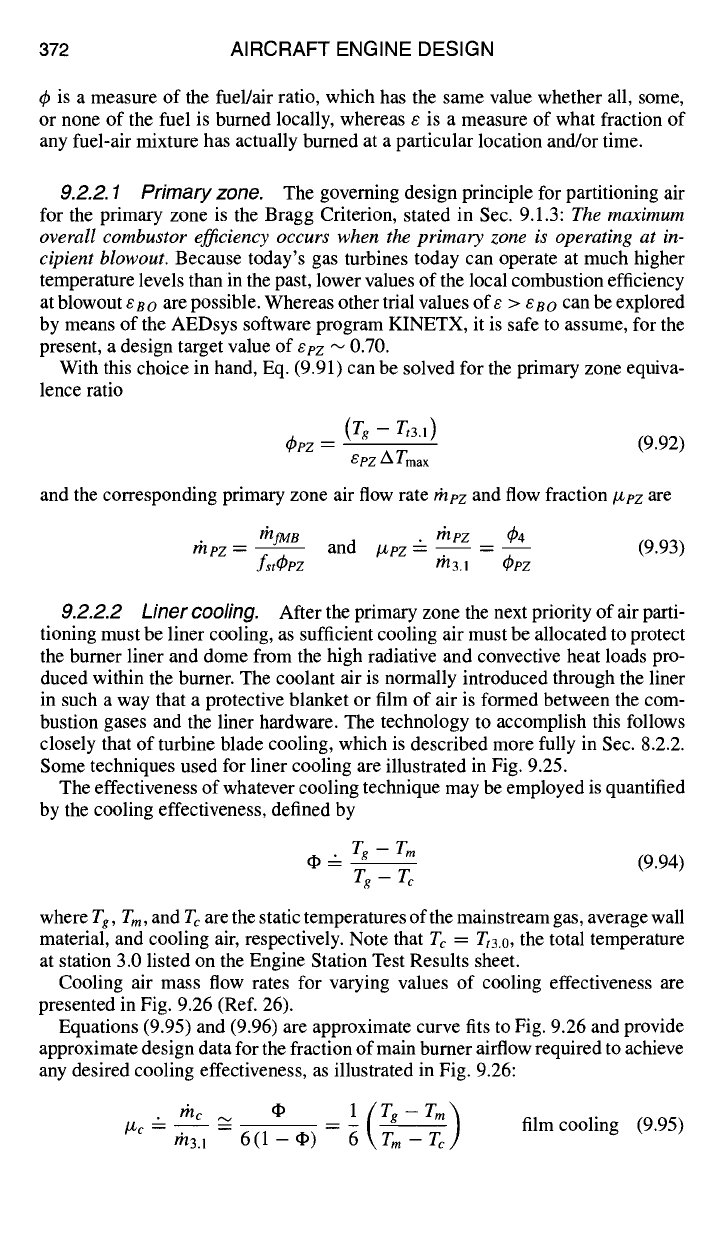
372 AIRCRAFT ENGINE DESIGN
~b is a measure of the fuel/air ratio, which has the same value whether all, some,
or none of the fuel is burned locally, whereas e is a measure of what fraction of
any fuel-air mixture has actually burned at a particular location and/or time.
9.2.2.1 Primary zone.
The governing design principle for partitioning air
for the primary zone is the Bragg Criterion, stated in Sec. 9.1.3:
The maximum
overall combustor efficiency occurs when the primary zone is operating at in-
cipient blowout.
Because today's gas turbines today can operate at much higher
temperature levels than in the past, lower values of the local combustion efficiency
at blowout eBO are possible. Whereas other trial values ofe > eBO can be explored
by means of the AEDsys software program KINETX, it is safe to assume, for the
present, a design target value of epz "~ 0.70.
With this choice in hand, Eq. (9.91) can be solved for the primary zone equiva-
lence ratio
(T. - T,3,)
~bpz -- (9.92)
e pz A
Tmax
and the corresponding primary zone air flow rate tnpz and flow fraction
tZez are
~n fMB rh pZ 4 4
thpZ- fst(bp~ Z
and #Pz- m3a" -- O~Pz (9.93)
9.2.2.2 Liner cooling.
After the primary zone the next priority of air parti-
tioning must be liner cooling, as sufficient cooling air must be allocated to protect
the burner liner and dome from the high radiative and convective heat loads pro-
duced within the burner. The coolant air is normally introduced through the liner
in such a way that a protective blanket or film of air is formed between the com-
bustion gases and the liner hardware. The technology to accomplish this follows
closely that of turbine blade cooling, which is described more fully in Sec. 8.2.2.
Some techniques used for liner cooling are illustrated in Fig. 9.25.
The effectiveness of whatever cooling technique may be employed is quantified
by the cooling effectiveness, defined by
• __ Tg -Tm
(9.94)
r.-rc
where
Tg, Tm,
and
Tc
are the static temperatures of the mainstream gas, average wall
material, and cooling air, respectively. Note that Tc = Tt30, the total temperature
at station 3.0 listed on the Engine Station Test Results sheet.
Cooling air mass flow rates for varying values of cooling effectiveness are
presented in Fig. 9.26 (Ref. 26).
Equations (9.95) and (9.96) are approximate curve fits to Fig. 9.26 and provide
approximate design data for the fraction of main burner airflow required to achieve
any desired cooling effectiveness, as illustrated in Fig. 9.26:
mc * l(Tg~Tm)
/zc -- "~ -- film cooling (9.95)
rh3.1 6(1 - ~) 6 \T,, - T~
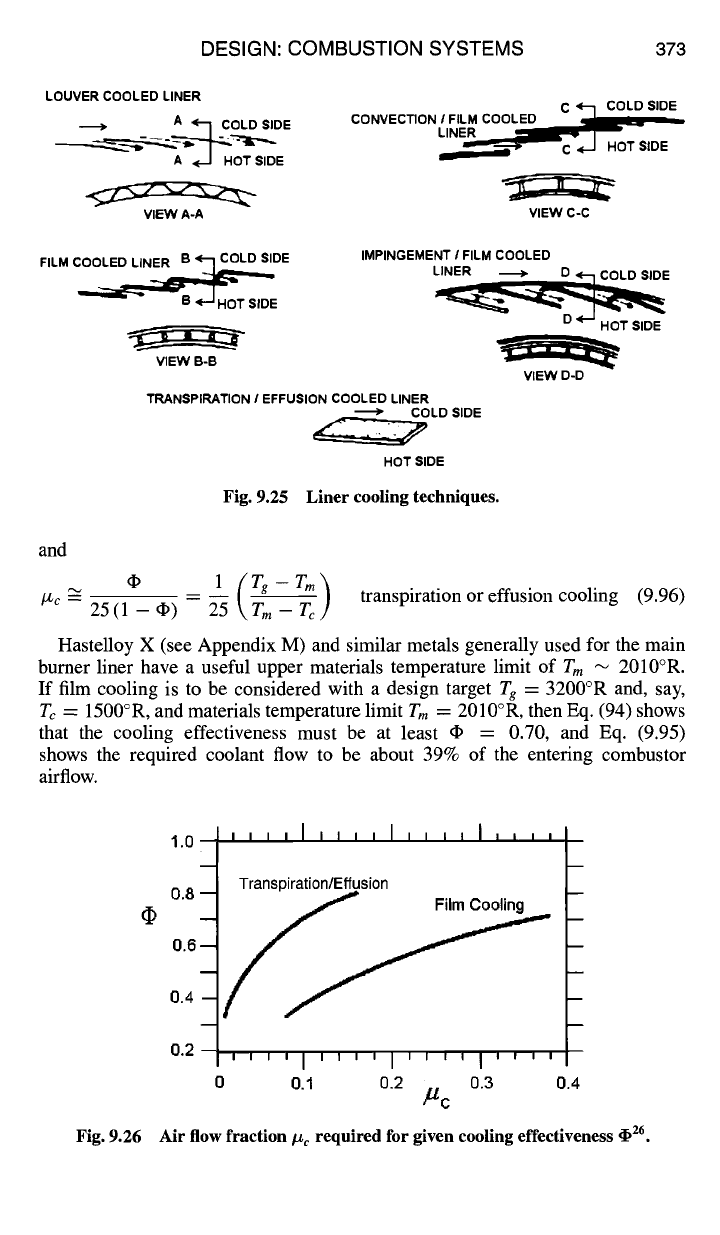
DESIGN: COMBUSTION SYSTEMS 373
LOUVER COOLED LINER
A <'7 COLD SIDE
A <_1 HOTSIDE
VIEW A-A
C ~--I COLD SIDE
CONVECTION I FILM COOLED
LINER
~C <_1 HOT SIDE
VIEW C-C
FILM C~ sIDE
= <'~ HOT SIDE
VIEW B-B
IMPINGEMENT I FILM COOLED
LINER , , L<_]COLDSID E
HOT SIDE
TRANSPIRATION I EFFUSION COOLED LINER
~
LD SIDE
HOT SIDE
VIEW D-D
Fig. 9.25 Liner cooling techniques.
and
* l(Tg=Tm~
/~c -- 25 (1
- d~ ) -- 25 \ Tm - Tc I
transpiration or effusion cooling (9.96)
Hastelloy X (see Appendix M) and similar metals generally used for the main
burner liner have a useful upper materials temperature limit of
Tm "~
2010°R.
If film cooling is to be considered with a design target Tg = 3200°R and, say,
Tc = 1500°R, and materials temperature limit
Tm=
2010°R, then Eq. (94) shows
that the cooling effectiveness must be at least qb = 0.70, and Eq. (9.95)
shows the required coolant flow to be about 39% of the entering combustor
airflow.
Fig. 9.26
1.0
0.8--
0.6--
0.4--
0.2--
,,,,I,,,,I,,,,I ....
Transpiration/Effusion
,~
Film Cooling
m
m
m
m
m
m
''''1''''1'' ''1 ....
0 0.1 0.2 //C 0.3 0.4
Air flow fraction #c required for given cooling effectiveness
¢I ~26.
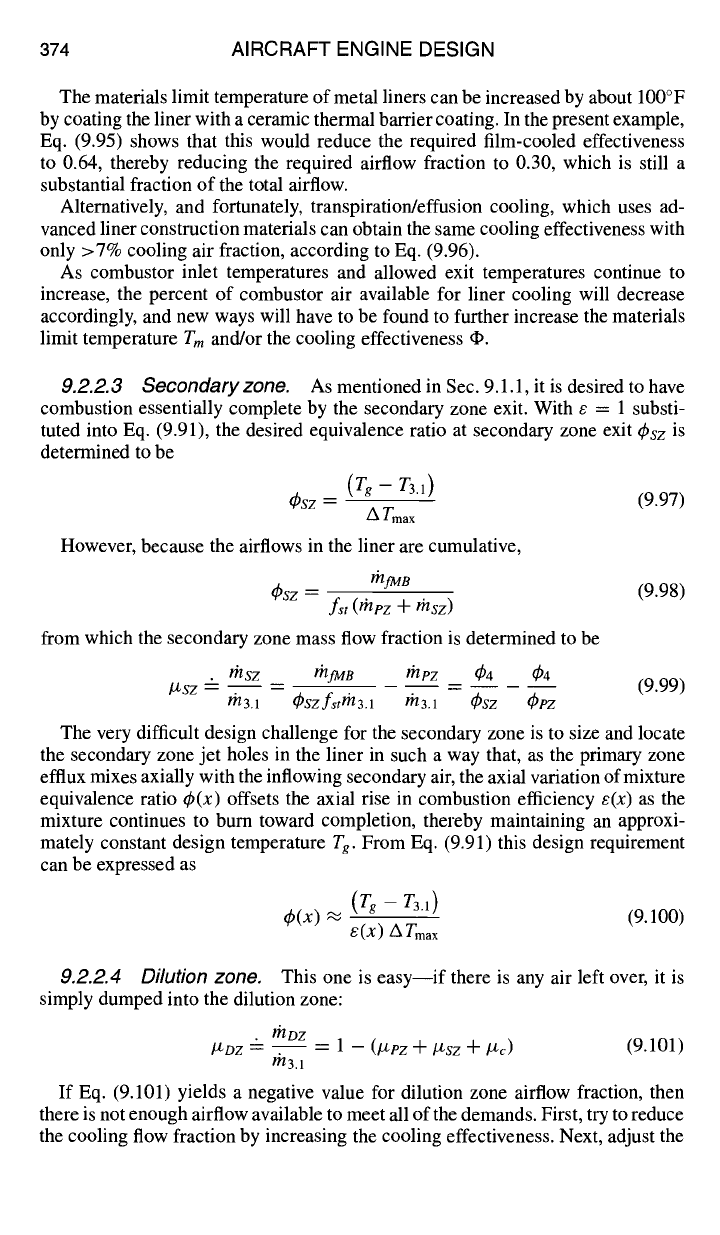
374 AIRCRAFT ENGINE DESIGN
The materials limit temperature of metal liners can be increased by about 100°F
by coating the liner with a ceramic thermal barrier coating. In the present example,
Eq. (9.95) shows that this would reduce the required film-cooled effectiveness
to 0.64, thereby reducing the required airflow fraction to 0.30, which is still a
substantial fraction of the total airflow.
Alternatively, and fortunately, transpiration/effusion cooling, which uses ad-
vanced liner construction materials can obtain the same cooling effectiveness with
only >7% cooling air fraction, according to Eq. (9.96).
As combustor inlet temperatures and allowed exit temperatures continue to
increase, the percent of combustor air available for liner cooling will decrease
accordingly, and new ways will have to be found to further increase the materials
limit temperature
Tm
and/or the cooling effectiveness ¢.
9.2.2.3 Secondary zone. As mentioned in Sec. 9.1.1, it is desired to have
combustion essentially complete by the secondary zone exit. With s = 1 substi-
tuted into Eq. (9.91), the desired equivalence ratio at secondary zone exit
¢gsz
is
determined to be
(T. - T3,)
q~sz -- (9.97)
ATmax
However, because the airflows in the liner are cumulative,
~bsz = rhfM8 (9.98)
fst (thPZ -}- IhSZ)
from which the secondary zone mass flow fraction is determined to be
l~l SZ #l fMB I~I pz 4 4 ¢94
tZsz
-- . -- -- -- (9.99)
m3.1
~Pszfstrh3.1
rh3.1
¢)sz ~bpz
The very difficult design challenge for the secondary zone is to size and locate
the secondary zone jet holes in the liner in such a way that, as the primary zone
efflux mixes axially with the inflowing secondary air, the axial variation of mixture
equivalence ratio ~b(x) offsets the axial rise in combustion efficiency
e(x)
as the
mixture continues to burn toward completion, thereby maintaining an approxi-
mately constant design temperature T,. From Eq. (9.91) this design requirement
can be expressed as
(T,-
r3.l)
q~(x) ~ (9.100)
8(x) ATmax
9.2.2.4 Dilution zone.
This one is easy--if there is any air left over, it is
simply dumped into the dilution zone:
•
mnz
I-tDZ -- . -- 1 -- (tZpZ + ktSZ + IZc)
(9.101)
m3.1
If Eq. (9.101) yields a negative value for dilution zone airflow fraction, then
there is not enough airflow available to meet all of the demands. First, try to reduce
the cooling flow fraction by increasing the cooling effectiveness. Next, adjust the
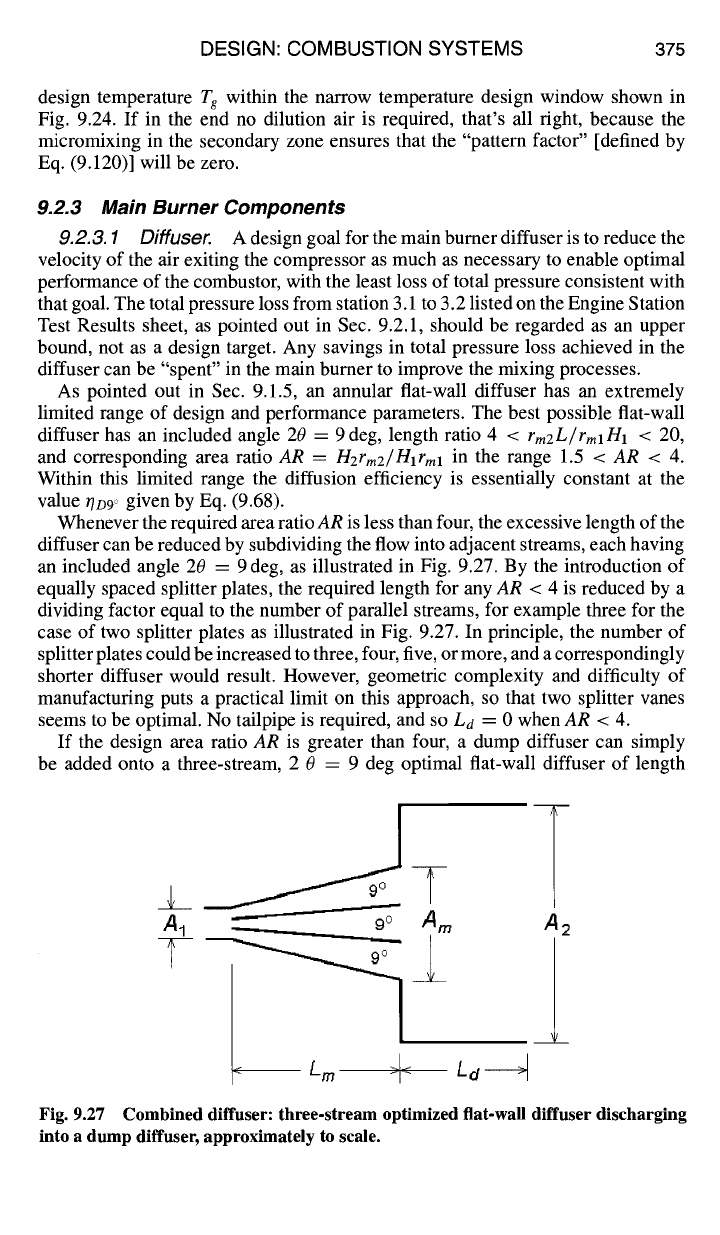
DESIGN: COMBUSTION SYSTEMS 375
design temperature Tg within the narrow temperature design window shown in
Fig. 9.24. If in the end no dilution air is required, that's all right, because the
micromixing in the secondary zone ensures that the "pattern factor" [defined by
Eq. (9.120)] will be zero.
9.2.3 Mare Burner Components
9.2.3.1 Diffuser.
A design goal for the main burner diffuser is to reduce the
velocity of the air exiting the compressor as much as necessary to enable optimal
performance of the combustor, with the least loss of total pressure consistent with
that goal. The total pressure loss from station 3.1 to 3.2 listed on the Engine Station
Test Results sheet, as pointed out in Sec. 9.2.1, should be regarded as an upper
bound, not as a design target. Any savings in total pressure loss achieved in the
diffuser can be "spent" in the main burner to improve the mixing processes.
As pointed out in Sec. 9.1.5, an annular flat-wall diffuser has an extremely
limited range of design and performance parameters. The best possible flat-wall
diffuser has an included angle 20 = 9deg, length ratio 4 <
rmzL/rmlH1
< 20,
and corresponding area ratio
AR = Hzrmz/Hlrml
in the range 1.5 <
AR < 4.
Within this limited range the diffusion efficiency is essentially constant at the
value tID9~, given by Eq. (9.68).
Whenever the required area ratio
AR
is less than four, the excessive length of the
diffuser can be reduced by subdividing the flow into adjacent streams, each having
an included angle 20 = 9 deg, as illustrated in Fig. 9.27. By the introduction of
equally spaced splitter plates, the required length for any
AR
< 4 is reduced by a
dividing factor equal to the number of parallel streams, for example three for the
case of two splitter plates as illustrated in Fig. 9.27. In principle, the number of
splitter plates could be increased to three, four, five, or more, and a correspondingly
shorter diffuser would result. However, geometric complexity and difficulty of
manufacturing puts a practical limit on this approach, so that two splitter vanes
seems to be optimal. No tailpipe is required, and so
La
= 0 when
AR < 4.
If the design area ratio
AR
is greater than four, a dump diffuser can simply
be added onto a three-stream, 2 0 = 9 deg optimal flat-wall diffuser of length
A1
90
A m
Lm _L
La
A2
l
Fig. 9.27 Combined diffuser: three-stream optimized flat-wall diffuser discharging
into a dump diffuser, approximately to scale.
